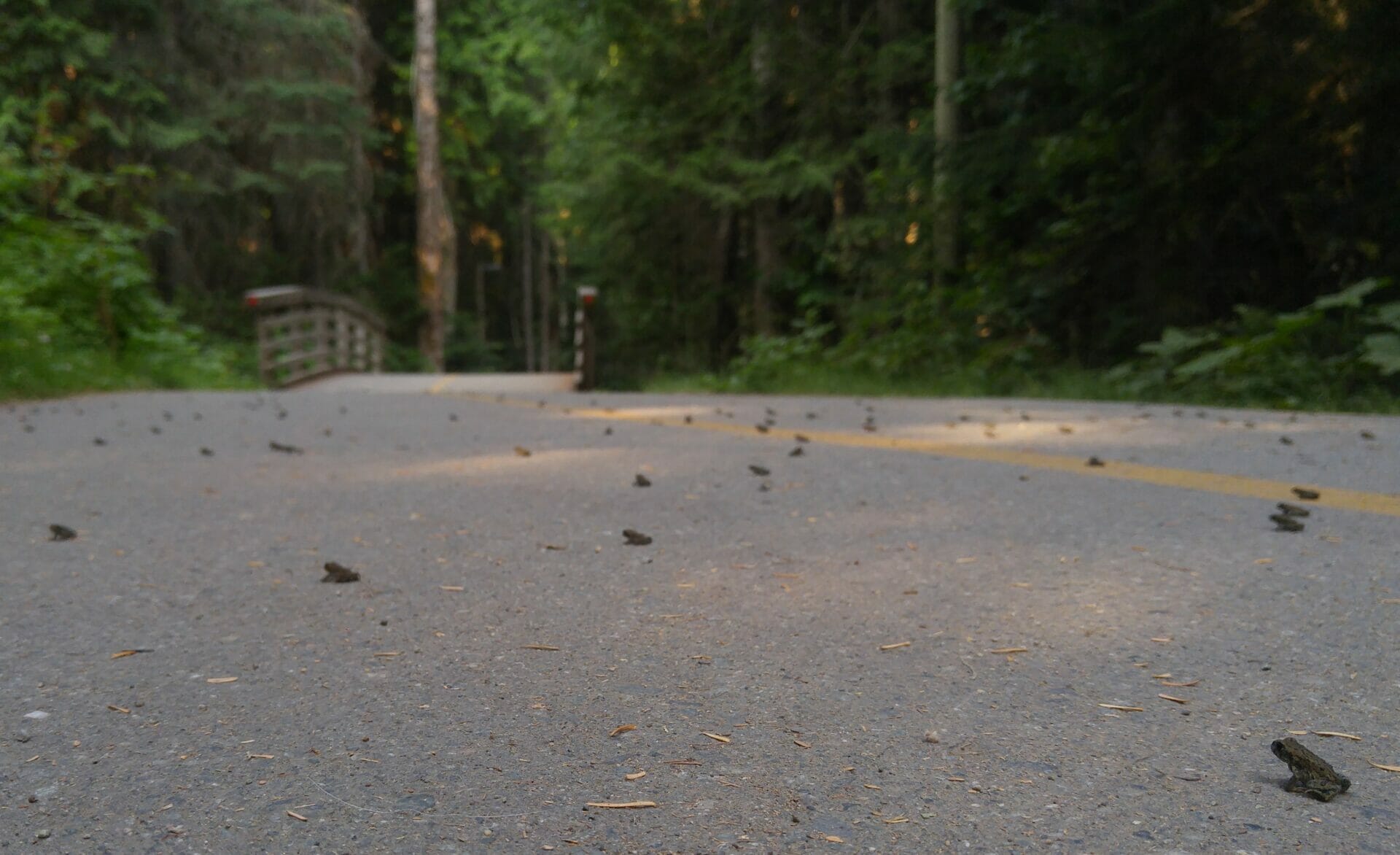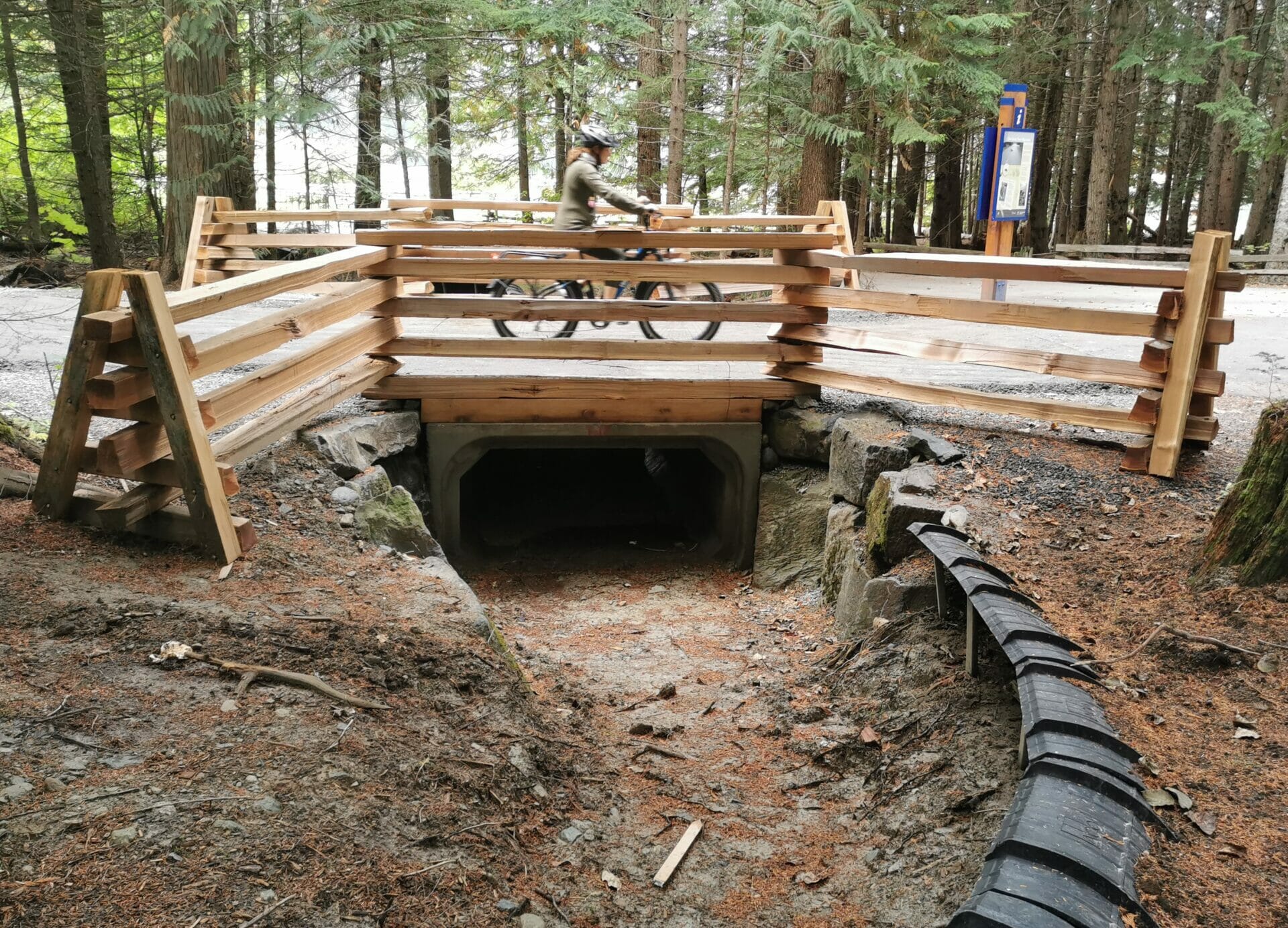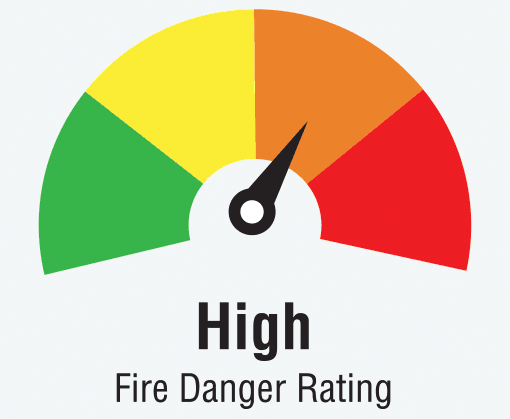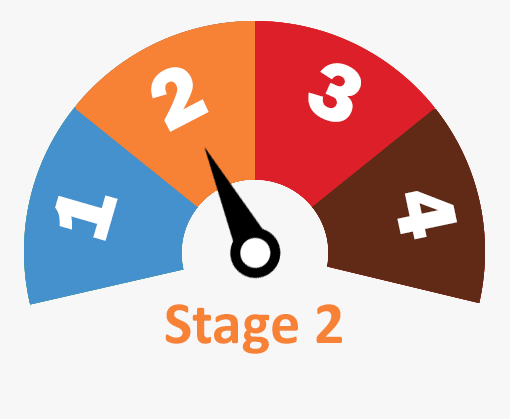
Whistler’s Lost Lake Park acts as the breeding ground for Whistler’s largest population of Western Toad (Anaxyrus boreas), a sensitive species native to British Columbia. Every year, thousands of Western Toads migrate from the shores of Lost Lake Park to the surrounding forest.
Western Toad update 2024
July 23, 2024: Western Toad migration to begin soon at Lost Lake Park
The very first Western Toads are beginning to emerge from Lost Lake. The remaining tadpoles are expected to complete their development and emerge throughout this week. At this point, newly emerged Western Toads will spend several days gathering along the shores of the Lost Lake Beach and Wetland before migrating through Lost Lake Park to reach the surrounding forest.
The migration typically starts near the end of July and lasts for 2-3 weeks in Lost Lake Park. During migration toads must cross trails, lawns and roads. In the past, many tiny toads have been crushed en route. To help give the toads a better chance at survival, Lost Lake Park undergoes a number of changes during the migration:
- Installation of informational signage throughout the Park
- Installation of infrastructure to help guide migrating toads
- Closure of trail and/or lawn areas where toads are actively migrating
- Potential for closure of the Lost Lake Access Road
There are no toad-related closures at Lost Lake Park at this time. Check back here for the most recent updates.
It is very important to not touch toads or tadpoles, as oils and chemicals on human hands can damage their sensitive skin. We also ask that visitors keep an eye out and pay attention to all signage and closures at Lost Lake Park in the coming weeks.
For those who would like to volunteer to help out with the 2024 Western Toad migration please contact our Environmental Stewardship Team at stewardship@whistler.ca.
Western Toads at Lost Lake Park
Lost Lake Park is the breeding ground for Whistler’s largest Western Toad population. We are very lucky to host such a large population of this sensitive species right here in our own backyard. Despite being barely the size of a dime, the Western toadlets are an integral part of the Lost Lake ecology. Tadpoles feed on detritus in the lake, which helps keep our lake water clean, benefiting humans and other species. The dime-sized toadlets have also found a place in the hearts of the many volunteers who have helped them on their journey from the lake to forest.
Western toads are native to British Columbia and are sensitive to changes in their environment. Human activities—especially roads and urban development that compromise forests and wetlands— are leading to the loss of suitable habitat and the creation of migration barriers for amphibians. Western Toad populations are particularly vulnerable during the tadpole and “toadlet” life stages.
How does the municipality help?

The RMOW has installed permanent features such as signage, fencing and an underpass to protect breeding and tadpole habitat. Closer to the migration, numerous temporary fences, signs and boardwalks are installed to help protect the migrating toadlets.
Recently, the RMOW has built new infrastructure to help migrating toads pass safely through the park. In 2020, a toad underpass was constructed under the Valley Trail just behind the events lawn. In spring of 2021, a second underpass was installed under the Lost Lake Loop Trail, between the Lost Lake Beach and Barking Bay. Underpasses have been strategically placed to allow toads to follow preferred migration routes without crossing high traffic trail networks. In addition to underpasses, the RMOW installed a new log retaining wall along Lost Lake beach to discourage toads from migrating onto park lawn areas where historic mortality numbers have been very high.
Once toads begin to migrate across the Lost Lake access road and parking lot, these areas will close to all vehicle traffic. When this happens, the free Lost Lake shuttle will continue to run, but visitors will be dropped off at the entrance to Lost Lake Park on Blackcomb Way and will need to walk the remaining 500 meters to the beach.
Lost Lake Beach, lawns and docks remain open. We just ask that those visiting Lost Lake Park during this period step carefully and walk bicycles as toads are no bigger than the size of a dime and can be easily crushed under foot. These areas may be subject to closure if they happen to coincide with major toadlet migratory pathways. This is difficult to predict as chosen migratory pathways can vary widely from year to year.
The RMOW’s environmental technicians and volunteers maintain a presence to monitor the migration and help the tiny toads move safely from the beach to the forest areas.
When does the migration happen?
Migration typically takes two to four weeks between the end of July and end of August.
How many migrate?
It is extremely difficult to estimate exactly how many toads there are migrating. Each female may lay up to 20,000 eggs and this years breeding pair count peaked at 40 pairs. This number is our best indicator of estimating population size.
Inventory and monitoring
- The RMOW has been monitoring the Western Toads at Lost Lake Park since 2005.
- The Western Toad population at Lost Lake, along with other monitored species populations, can provide insight into the broader health of Whistler’s ecosystems.
- Monitoring the stages and development of the tadpoles throughout the summer enables the RMOW to proactively prepare for the migration and focus on public education.
- The RMOW observes around 35,000–40,000 toads annually during migration.
Policy and planning
- The RMOW is working to integrate protection of Western toads and other species at risk and their habitat at a policy level, for example in the Official Community Plan.
- The RMOW considers Western toads and other species at risk and their habitat when reviewing development proposals.
- With respect to parks, facilities and events planning, the RMOW occasionally closes the special events area at Lost Lake Park during the migration period to support the passage of Western toads. While this may result in some initial disappointment for those having to postpone their special events, the RMOW is confident that saving the tiny toads makes it worth the wait.
Working with partners
- It takes a village to support the toads.
- The RMOW works with multiple community partners on Western toad monitoring and migration initiatives, including the Whistler Fisheries Stewardship Group, the Community Foundation of Whistler, the Whistler Naturalists, the Whistler Museum and Archives and many more toadally awesome community members.
On the ground
- The RMOW has installed permanent features including fencing, signs and an underpass to protect the breeding and tadpole habitat along the shoreline of Lost Lake Park and migration route to the forest.
- In addition to permanent features, a number of temporary fences, signs, boardwalks are installed closer to migration.
- The RMOW may close sections of Lost Lake Park during migration to support the toads’ safe access to the forest areas.
- To protect the toads during the summer migration period, the RMOW asks residents and visitors to be cautious when biking or walking in the area.
- Residents and guests are encouraged to be careful, be respectful and help the little guys make their way home.
How can you help?
- If you visit Lost Lake Park during the summer Western toad migration, be careful, please be respectful and help the tiny toads journey safely to their forest home.
- Volunteer to help the toads migrate safely. Contact our Environmental Stewardship team: stewardship@whistler.ca.
- Learn more about Western toads and other species at risk.


